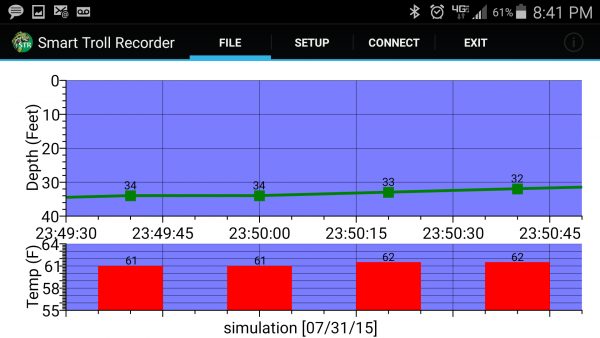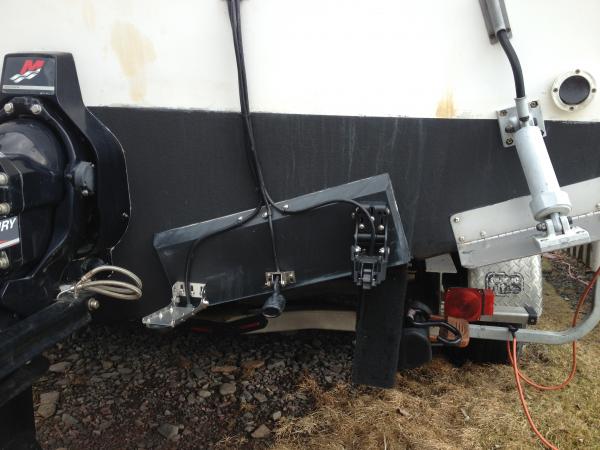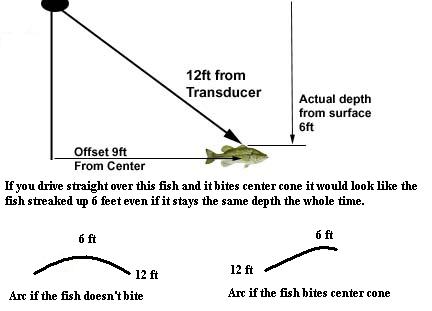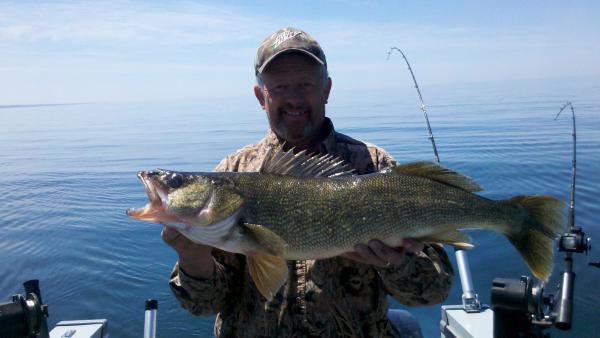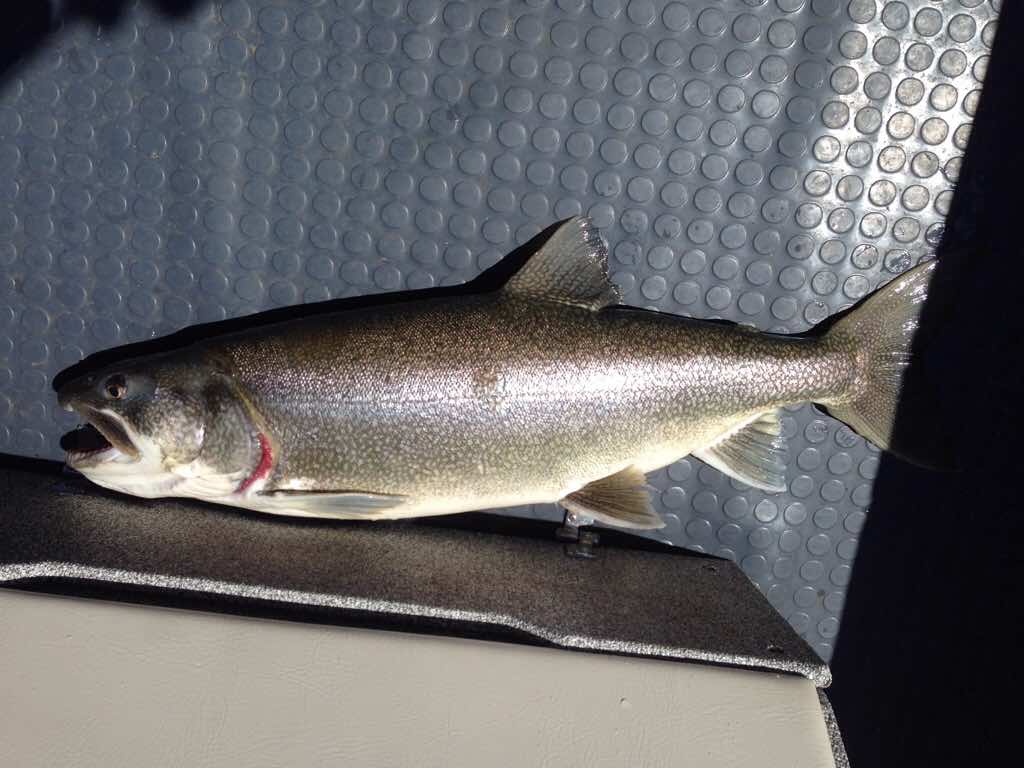-
Posts
75 -
Joined
-
Last visited
Content Type
Profiles
Forums
Events
Gallery
Store
Everything posted by Smart Troll
-
AnglingAddict, The data is sampled every 20 seconds. Below are some screen shots that represent what the recording will look like. Please note that it is military time to distinguish am from pm and the simulation was recorded at mid-night so it went from 23:50 to 00:00 The first attachment is the "Home Screen" and it shows changes of depth in the top section and corresponding changes in temperature in the bottom section. The second attachment shows labels that pop up if you touch anywhere on the screen. The third attachment shows that labels appear at every data point when you zoom in. You can zoom either by touching the screen for a second or by finger gestures. The fourth attachment is just zoomed in further. Looks like the attachments ordered themselves from right to left so...start with the one on the one on the far right.
-

Which down speed & temp system do you recommend?
Smart Troll replied to Todd in NY's topic in Tackle and Techniques
Pap, Just thought i would let you know the reason I don't make a dedicated "Smart Troll" display. The main reason is because I can't make a display that allows you to easily download any updates to the app and install any other app you want to use on it (such as fish finder display, GPS, navionics, etc) for $49 USD...such as the one at the link below. Smart Troll uses Bluetooth to transmit the depth/temp data so you do not need phone service at all. In fact, you could use an old android phone that has been disconnected from phone service and it will still work fine with Smart Troll. http://www.amazon.com/Fire-Display-Wi-Fi-GB-Special/dp/B00TSUGXKE/ref=sr_1_2?ie=UTF8&qid=1453094815&sr=8-2&keywords=fire+bluetooth In summary, you get to choose the size and cost of your display. One guy might want phone size so he can keep it in his pocket...the next guy might want TV size for his boats console....Smart Troll doesn't lock you in to a one size fits all display. Plus, anytime I upgrade the app you can download the latest for free. That way you don't get stuck with an earlier version of the app just because you bought before the other guy. -

Which down speed & temp system do you recommend?
Smart Troll replied to Todd in NY's topic in Tackle and Techniques
Todd, Just thought I would chime to let you know that I put that information about two transducers because I could see the possibility when Smart Troll was first launched. However, to date there has NOT been any user or boat that has needed two transducers so it appears that in practical use it is not an issue. Just mount the transducer outboard (away from the motor) as much as possible and you still have line of sight to the Probes that are on the opposite side of the boat because they are down and behind the boat a hundred feet or so. Since the Probes can be attached directly to the line you are getting signals basically straight from the lure. You will be surprised how much small changes in down-speed affects the depth of the lure. o.5 MPH can change the depth by 20 feet or more. Even if you don't have a Probe with Speed...you can tell the speed changed because the depth of the lure will change. Of course, other things can make the depth change also such as a small fish that doesn't trip the release, if you pick up a weed or trash, if your diver release pops even if there is no fish on, etc... And the depth will also change during turns and in waves (because of the pulling back and forth on the rod tips). The point is if you have it set at 50 feet (or whatever) and the depth changes even though you didn't change anything it is up to you to figure out why but at least that change doesn't just go unnoticed for a couple of hours. If everything seems OK...then you can take whatever is action necessary to get back to your target depth or temperature. Or if you catch a fish during a turn with Smart Troll you can see how deep your gear was when the bite happened so you would then have a new "target depth". -
Big Water, Clearly I am "overly analytical" too and when I elaborated on some of the theory I certainly didn't mean to imply anything about your understanding of it all...after all I can see you are "Pro Member" Your original post about fish streaking up on the fish finder screen just brought to mind the theory that when fish appear to have streaked up from 20 feet or more they almost certainly traveled lots less than that through the water column because of the way the fish finder cone works. I appreciated your question because it gave the opportunity to think it all through again and being over analytical it is easy to get carried away with some of the posts. It was kind of fun to put it all down in writing...but I guess that is just the analytical nerd in me.
-
lost a lure, One thing for sure that hasn't been well stated is that the fish finder screen is a history. By the time the fish arc is fully formed the fish is completely out of the transducer's cone (it started at one edge of the cone and the trailing edge of the arc is the fish exiting at the opposite edge of the cone). So, if the cone is 30 feet wide then the fish is already 15 feet behind the boat when the trailing edge of the arc is formed. That 1 inch (or so) wide arc would have been formed as the fish passed through 30 feet of the transducer's cone. The only pixel that is close to "live" is the one forming on the very edge of the fish finder screen. What is seen at the opposite side of the screen happened some time ago depending on the scroll rate of the screen. If it takes 30 seconds for something to scroll from one edge of the screen to the opposite side of the screen...then what you see on that opposite edge of the screen exited the transducer's cone 30 seconds ago.
-
Big Water, The point I wanted to make is the fish arc is formed when the fish is not moving much relative to the boat but you can use that to sort of determine how deep the fish appears to be when at the outer edge of the cone compared to the center of the transducer's cone. If you use the example screen shot below you can see that can be 20 feet or so. For a specific setup it depends on how wide the cone is on your transducer and how deep the fish is (because the cone gets wider with depth). But suppose the fish is swimming along in the same direction as the boat but slightly slower than the boat. You will loose the arc shape and it will be elongated because the fish remains within the cone much longer if it is swimming with the boat. If the boat is going slightly faster than the fish is swimming then that elongated shape will angle up as the fish moves from the edge of the cone to the center of the cone and it will appear like the fish streaked up and then fell away even if the fish remained at the same depth the whole time. ** **
-
Big Water, I have no doubt that fish will sometimes notice a presentation and swim up to look at it...but they might not always come from as far away as it looks on a fish finder because of how the cone area works. Please consider the attached illustration. If that fish stays at one depth and you drive the cone of the fish finder directly over the top of the fish it will look deeper when it first enters the cone than it looks at the center of the cone. That is why fish appear as arcs...they enter the edge of the cone farther from the transducer and thus look deeper. as they approach the center of the cone they look shallower and shallower. As the fish passes towards the opposite side of the cone getting farther from the transducer...it looks deeper and deeper again. If the center of the transducer's cone gets directly over the fish and it starts to swim along you would not see the trailing side of the arc because the fish is swimming along with the boat and staying in the same relative position under the transducer's cone...and the fish would have appeared to streak up even though in this example the actual depth of the fish did not change. If the fish is swimming along with the boat near the edge of the cone and then speeds up so it is directly under the center of the cone it will appear to have streaked up even if its depth doesn't change because it is farther from the transducer when at the edge of the cone area and closer to the transducer when directly under the transducer. The arc is most pronounced if the fish travels directly under the transducer but less pronounced if the fish is in the cone but off to the side...never directly under the transducer. The only time the fish is at the depth indicated on the fish finder is when it is directly under the transducer. All other times the fish will appear to be deeper than it actually is. The fish finder tells you the distance between the fish and the transducer. The animation and explanation below was copied from here...The right side of the animation is showing the arc forming as the transducer passes over a fish that remains at one depth. http://support.lowrance.com/system/selfservice.controller?CONFIGURATION=1001&PARTITION_ID=1&secureFlag=false&CMD=VIEW_ARTICLE&ARTICLE_ID=2967 Why Fish Arch The reason fish show as an arch is because of the relationship between the fish and the cone angle of the transducer as the boat passes over the fish. As the leading edge of the cone strikes the fish, a display pixel is turned on. As the boat passes over the fish, the distance to the fish decreases. This turns each pixel on at a shallower depth on the display. When the center of the cone is directly over the fish, the first half of the arch is formed. This is also the shortest distance to the fish. Since the fish is closer to the boat, the signal is stronger and the arch is thicker. As the boat moves away from the fish, the distance increases and the pixels appear at progressively deeper depths until the cone passes the fish. If the fish doesn't pass directly through the center of the cone, the arch won't be as well defined. Since the fish isn't in the cone very long, there aren't as many echoes to display, and the ones that do show are weaker. This is one of the reasons it's difficult to show fish arches in shallow water. The cone angle is too narrow for the signal to arch.
-
Jim, The data is stored in the filed/document directory of the phone as a CSV file. So, you can navigate to that file and make a copy and import it to a table or database if you desire. I do NOT plan to make a version with Speed because it will drive the price up too high and it will make the Probe too bulky because of the required paddle wheel and housing to incorporate SPEED. The STR Probe is pretty close to the size of a man's pinky finger so it won't affect the depth much which makes it useful information for your gear even when the STR Probe is NOT on the line. a Probe with Speed, as mentioned above, would be much bulkier so the depth of the gear would be affected more. Therefore, the Depth/Speed relationship with the Probe on the line would not compare to the Depth/Speed relationship with no Probe. On the Smart Troll systems that have Probes with LIVE data...the bulk of the Probe doesn't matter because you are seeing both the Depth and Speed LIVE.
-
I thought I would post my recent Newsletter here for those who might be interested. January 2016 Smart Troll Newsletter First let me wish everyone a Happy New Year...hoping you have lots of fun and success out on the lakes in 2016. This newsletter will be brief...I just want to start the year off with a few announcements. I have been dragging butt on getting the new Website launched...but it is almost ready and should be up and running by the end of January. There is an "Early Bird Special" for anyone who purchases a Smart Troll kit before February 29th, 2016 (yep...it is Leap Year). You can get a FREE PROBE and an Extended Warranty. Check out the Home Page of www.smarttroll.com for details. A new Smart Troll Product will soon be available called a "Smart Troll Recorder" or STR for short. It is a great addition for the budget minded fisherman who wants invaluable information about the Depth and water Temperature of their gear. It is a standalone Probe that records Depth and Temperature in real time. You can attach it to your line (near your lure) and leave it there for hours (or as long as you want). If you deploy it at 6:00 am write that in a log, make a turn at 7:30...write it down...catch a fish at 8:00 again write the time down of any change you make. If you make a turn and catch a fish during the turn just put the time in your log. Then when you retrieve the line and the Probe you can play back the recording on any android device to see a graphical representation of the depth and temperature recorded every 20 seconds. And the time in the recording is "real time". Meaning...if you wrote 8:26am in your log you can look at the 8:26am time stamp in the Probes recording and see what happened at that exact time. So, let’s say you made a turn and caught a fish on the inside of the turn at 8:26 am. When you play back the recording and look at 8:26 am in the recording then you can see exactly what happened at that time. Perhaps the Probe/Lure went 15 feet deeper and the water got 8 degrees colder...that information will be in the recording. Not as good as live data but it will definitely help you to learn what is happening with your gear and all of your different lures and setups. Expected availability...March of 2016; Expected price...Well under $200 I am very busy preparing for the 2016 season...and I am optimistic it will be a great year for all of us. Feel free to shoot me an email if you have any questions...or call if you want. I am also happy to reply to any questions or comments posted here at LOU Darrell Huff [email protected] 443-262-1269
-

trolling and the current?
Smart Troll replied to hawkeye625's topic in Questions About Trout & Salmon Trolling?
Yes, it was just a generality. I agree when they are feeding you might find them anywhere. It is the same in a stream but I still have pretty good luck in the eddys and deep holes where the water is slow moving. -

trolling and the current?
Smart Troll replied to hawkeye625's topic in Questions About Trout & Salmon Trolling?
In a stream the big fish find slow moving water (where they don't have to expend much energy) and lie in wait for bait to come down the stream to them. Like sk8man said a lake has a vertical factor...so they can lurk under the current and look up. My theory is...find the depth where your lure is low in the in the current layer and the big fish will be just under the current waiting for your lure to swim past. -
We now have a Smart Troll kit designed for a Kayak but can also be used on a canoe or other small boat. The Kayak Kit comes with a transducer that is designed to attach to a Kayak rail and a self-contained Power supply. All you need to use this kit both on the Kayak and the big boat is a transducer. Here is the link... http://smarttroll.com/index.php?main_page=index&cPath=10&zenid=ec8e65da9c85657a7ca392881f09f54b
-

trolling and the current?
Smart Troll replied to hawkeye625's topic in Questions About Trout & Salmon Trolling?
hawkeye, Sometimes down-speed can be deceptive when measuring it at the DR ball because the ball is often not in the same current as your lures. For illustration suppose there is a current mid-lake...like between 30 feet deep and 50 feet deep. If your ball is 60 feet deep it will not measure the down-current. The DR ball will punch through the current even when traveling against it...but your lures won't. That is why sometimes when looking at the way your gear runs you can tell something changed when you change directions even though your measured down-speed appears to be nearly the same in both directions. If down-speed changes by 0.5 MPH the depth of your lures can change by as much as 30 feet. So when changing directions that is only a 0.25 MPH current. In other words traveling against a 0.25 MPH current then turning 180 degrees so you are traveling in the same direction as a 0.25 MPH down-current that is a change in down-speed of 0.5 MPH. If your cannon ball is in the same current as your lures you will see the change...if the cannon ball is below the current then it might appear that down-speed didn't change much. -
JC, Sk8man X2... The lures and DR ball will often NOT be in the same current. But if you get the unit that measures depth then you can slowly lower the downrigger and monitor down-speed at different depths in the water column. At least that way you get a snapshot of the current and your lures will most often get hung-up in the fastest current because they cannot punch through like a DR ball can. Some captains don't attach a line to the downrigger they are using for that purpose so they can frequently raise and lower the DR ball to monitor the current at different depths. Otherwise, if the current changes your ball might be below the current layer so it wouldn't detect it. You could do the same thing with the DR line counter but it will be less precise due to counter inaccuracy and blow-back.
-
LongLine, My main point in the original post in this thread is...if the speed is not right then the depth will NOT be close. If you are 20 feet above the fish at the "right speed" then you could be 50 feet above them going 0.5 MPH faster. I know they might sometimes run that far and bite the lure but I am betting if pressed you would agree that it is better to both be close and the right down-speed. For the past two years my Pro-Staff and Smart Troll users have been telling me to develop a Probe with Speed and I would always tell them "If you duplicate depth then you duplicate speed"...but they were persistent (and often almost mad at me) so I did develop a Probe that attaches to your line and transmits Depth/Temp and Speed. But, I have to admit that until this thread I still didn't really get the need for it because I pictured going out and trying different things until you catch a fish and then duplicate those conditions. In that case if you have the exact same setup and you let the exact same line out...if you adjust the boat speed until you duplicate the depth where you caught the fish then you have also duplicated down-speed. What I didn't get is....change anything on that setup and now you have to learn all over again what depth that new setup runs at the "right speed". But...by measuring depth and SPEED you have the ability to target both a specific depth and speed at the lure. Now I see that instead of experimenting to get it right it is better measure to get it right. I agree with every point you have made and I get it...that it is tough to experiment or control all of those variables. Thanks for helping me get there!
-
LongLine, The first time I read this i was just focused on the fact you were using a Downrigger but when re-reading it it sunk in that you were dragging the bottom. Sorry it took me so long to get it... Your scenario...dragging the bottom going against the current and you turn around so you are still dragging the bottom going with the current and there is no depth change you say. Hahaha...lol! I can't believe I didn't get it the first time. I think we can all agree with that...once you get to the bottom your gear won't go any deeper no matter what you do. Thanks for the humor...
-
Many thanks to everyone who has commented in this message string. You have helped me to understand there are too many variables and too many fishing methods for the statement that you can determine down-speed by depth alone to be true in every situation. I pictured someone trolling along on a particular day who catches a fish and if that person put that same setup back exactly as it was then the same depth would also be the same down-speed. But day to day all the other variables come into play and it is hard to duplicate the same line, same counter, same lure and so on. I now understand that you cannot always determine down-speed based on depth alone (only in the case where you are putting the same exact setup back exactly as it was) and you also cannot always predict the depth of your lures based on down-speed alone because the same variables come into play. Depth and down-speed do have a direct correlation but I neglected to think about all of the other variables so thanks again for enlightening me.
-
LongLine, I agree a with a downrigger ball the depth won't change much. Please excuse me for not clarifying that. My comments are based on the depth of everything in your spread that is not attached to a downrigger. But someone recently brought to my attention... there are other variables that will affect the down-speed to depth relationship such as line out, line diameter, variations in the divers or other gear. So, for my statement to be true all of those variables have to be consistent. You can do that on a given rod on a given day but I would agree that is difficult to do day to day. Getting a knot and cutting your line shorter (for example) will change the counter and throw everything off. Change out the lure and again...everything can change. In light of that I would have to admit that if you want to quickly and consistently control your down-speed day in and day out you would want to use a probe with down-speed.
-

26lbs of laker w/ pics
Smart Troll replied to SharkHunter's topic in New York Fishing Reports - Lake Ontario (South Shore)
-
LongLine, Yep...I agree all of those things happen. Sometimes they will hit anything and other times they are really picky and sometimes they will come out of nowhere...chase your lure down and hit it hard. Still, I think overall your odds of getting a hit are better if you get close to the fish rather than 30 feet away. I don't say down-speed doesn't matter at all...I just claim 2 things. 1) If you know the depth of the lure then if you duplicate depth then you also automatically duplicate down-speed 2) If you change your speed by 0.5 MPH (2.0 to 2.5 MPH for example) the lure action changes but the depth also changes a lot. If it is all about lure action then I can't explain why one boat is catching fish at 1.8 - 2.1 MPH and his buddy catches fish 2.5 -2.8 MPH. But, having said that I agree if they are in the mood to follow the lure and look it over for awhile then it better look right.
-
Silver Fox, Yes...I am biased But, I am also just trying to make sense of it all. I like to post on the forum and because I am a Sponsor I will always have a bias but I don't hide who I am. My avatar and screen name pretty much identifies who I am. So, I have a choice don't post...or be open about who I am. I hope that my openness is enough but if there are complaints then I will revert to the choice to not post.
-
TyeeTanic, I get it...if you have Depth, Temp and Speed at the lure you have it all...{;~)[ If you know the speed and depth of the water at the lures you can figure how deep your gear runs at various down-speeds real fast instead of over a longer period of time.
-
G-Daddy, I am quite a bit north of you near Kent Island. But, plenty close enough so we should go fishing together sometime. Are you fishing the MSSA tournament this week-end?
-
TyeeTanic, Thanks for the excellent points you made in your post and I certainly agree with all of them. You made me realize that I have been emphasizing depth so much I guess I have implied SPEED is not important at all. And with a speed Probe you can probably get everything setup faster because it takes a few for the depth of everything to stabilize. But it is also true that all things being the same (same line, same reading on the counter, same lure, etc). If you duplicate the depth then you are also duplicating the speed. If you are fishing in water with no current and the lure is 50 feet deep...if you come into a 0.5 MPH current that you are traveling against the lure will rise 10 to 30 feet in the water column. If you slow down until the lure is again 50 feet deep then you have duplicated the same down-speed you had before. If you turned around so you was traveling in the same direction as the current the lure would go deeper. In that case...if you speed up until the lure is back to 50 feet deep then you have again duplicated the down-speed as well. That is why I said in a post near the beginning that in my opinion you don't need a Smart Troll Probe with "Speed" IF you have Probes attached to the lines that show depth and temperature. I didn't mean Speed is not important at all. I meant there is a direct correlation between Depth and Speed so if you get bites at a certain depth...if you don't change anything else but adjust the boat speed to get the lure back to the same depth then it is also duplicating the down-speed. The bonus is that you can also tell if a Dipsy pops or if you catch a shaker or pickup weeds or come into a mid-lake current, etc...because all of those things will affect the depth of the gear. Having said all that...clearly any information you can add to the mix can help you get fine tuned quicker. If I had to make a choice I would choose Depth and Temperature...but adding speed to the mix is a sharper edge for sure.
-
G-Daddy, The only question I have is when you get "repeatability" by controlling the down-speed which is the bigger factor? The fact that your lures are running the same speed or is it because when you are duplicating speed you in turn are also getting your lures at the same approximate depth? Depth and Temperature data helps you to pinpoint that temp break.


